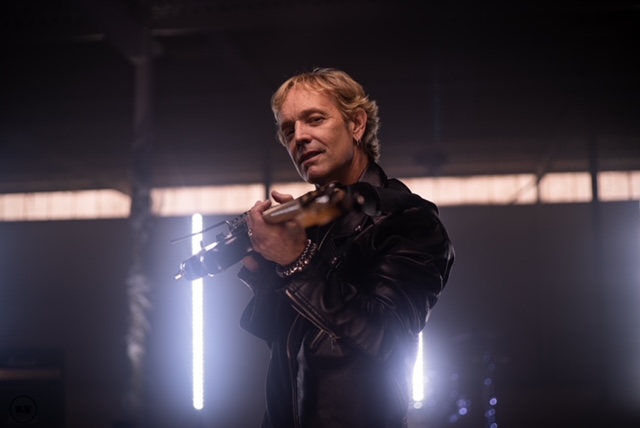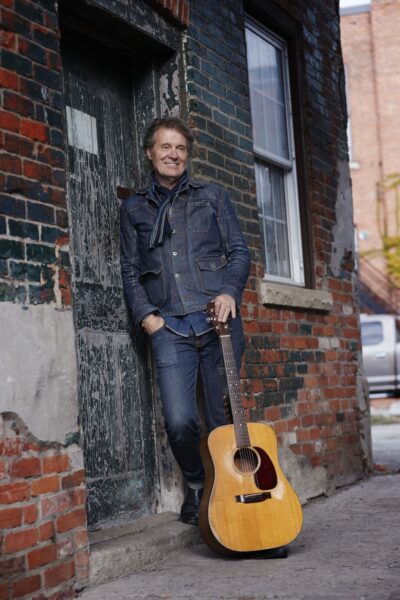Ottawa’s NAC Presents, featuring an all-Canadian series of shows, has set out to highlight a genre-hopping array of some our nation’s finest talent from coast to coast this year. On this particular night, two such performers took to the grand stage of Southam Hall, whose acts perfectly complimented each other — Basia Bulat, and Daniel Lanois. Ottawa’s world class NAC Orchestra, led by Maestro David Martin, further enhanced the works of these two artists into breathtaking brilliance.
Canadian singer/songwriter and multi-instrumentalist, Basia Bulat, chosen by Daniel Lanois himself, opened the night, with a well-plucked selection of her past and present material in a stirring performance that was for me, cut too short. She walked onto the stage, dressed in a pretty frock bearing a cool psychedelic design and took her place front and center, amidst a sea of musicians looming behind her. However, she is no stranger to having her music lovingly adapted in an orchestral setting, and one could sense her ease and empowerment within the fullness of the sound around her.[quote]The two looked as if they were charting a course to outer space[/quote]
I was impressed by her proficiency and intrigued by her choices of old world stringed instruments she played throughout the evening. She sat on a stool to play the pianoette on a tender piece entitled, “The Shore” (Heart Of My Own – 2010). I loved the kettle drum swells, and the gentle ebb and flow of the orchestra, which allowed the audience to savour her acoustic work. Her voice rang out like a sounding bell above the music, but blended beautifully with the full instrumentation. She then picked up a charango (a small 10-stringed Andean guitar) for “It Can’t Be You” (Tall Tall Shadow – 2013). Her vocals wove through the song like an ancient reed instrument, full of delightful trills, vibrato, and accents, in a quality somewhere between Joni Mitchell and Joan Baez. The pristine acoustics inside Southam Hall picked up every timbre of her voice, even when she stepped back a few feet from the microphone.

For the next couple of songs, Bulat moved to the grand piano and played solo. More notable vocals resounded prominently, in particular during her title track, “Tall Tall Shadow” (Tall Tall Shadow – 2013), a wonderfully robust melody that grew in intensity as it went along. She moved away from the piano and stepped up to the mic to lend her pure vocals on another of her strong pieces, “Five Four” (Tall Tall Shadow – 2013). The medieval tones of the song were brought to full-flowing lusciousness by the orchestra, which added a wash of movie score grandness. By the end of her abbreviated set, Basia Bulat showed the hushed and appreciative audience her natural prowess as a musician, singer, and songwriter.
At 63 years of age, the career of Canadian legendary producer, musician, and songwriter, Daniel Lanois has spanned over forty years. Last night, he displayed his absolute mastery of ambient sounds and textures in his own material, with well over an hour’s worth of picks from as far back as his first compositions, to selections from his most recent effort, Flesh and Machine (2014). This album delves deep into Lanois’ ever-changing vision, experimentation, and exploration of human and synthetic sounds, weaving them into a colourful palette of mood stimulating wizardry.
Tonight, the NAC Orchestra merged their arrangements of Lanois’ material with amazing precision, interpretation, and adaptation, having only had time to rehearse once the previous day together.
Lanois began with a sample of what he terms a “deconstructive” technique, in a piece entitled, “The Deconstruction of Early Days”…a method of experimentation he used primarily on his new album that he learned from Brian Eno way back when. It involves what he calls the removal of the “spine” of a song, leaving only the enhancement tracks in the foreground. Both Lanois and engineer, Wayne Lorenz, worked side by side to work the mixing console. The two looked as if they were charting a course to outer space, as they tweaked dials that generated a variety of samples and textures.
Lanois moved to the grand piano to play “Iceland” (Flesh and Machine), a very lush and soothing piece in three-quarter time, which featured co-engineer, Alex Krispin on vocals. The orchestra’s softly layered strings, along with the mesmerizing drone of the bass drum, added to the song’s hypnotic tranquility.
“Sonho Dourado” (Friday Night Lights – 2004), meaning “golden dream”, had a beautiful flowing melody, which honed in on Lanois’ gorgeous tones of the pedal steel, reverberated in a mournful cry while the deep resonance of the drums, achieved with timpani mallets, muted the music perfectly in a warm blanket of rhythm.
Lanois headed back on the synth board for the first half of “Two Bushas“ (Flesh and Machine). ”Okay David“, he cheekily quipped to the conductor, “…beat that, man”, stirring the audience into laughter, as Lanois and his band took a back seat to allow the orchestra to play the second half of the song in their own arrangement.
A cameraman onboard the stage gave the audience a bird’s eye view of the musicians as they played their instruments. Up close shots of Lanois on the pedal steel again during the tribal flavoured, “Senegal”, zoomed in on his hands as they gently danced across the strings like a painter waving strokes across his canvas. Intricate and changing syncopations were skilfully played by Kyle Crane on the drums, completely complimented by the bottom end rhythm of Jim Wilson on bass. Synth embellishments gave the pedal steel guitar a very whale-like tone, which brought the house into atmospheric bliss.
[youtube width=”600″ height=”400″ video_id=”qBw3S9IAKPc”]
After a brief interlude of birthday wishes for Wilson onstage, complete with lit candles on a cake, Lanois strapped on his Les Paul for one of his early pieces from the past, “Still Water” (Acadie – 1989). Wilson delivered some great vocal harmonies, and Lorenz made the music breathe with nuances, echoes, and swells, added in all the right places. The band lingered in the timeframe with, “Jolie Louise”…one of the first songs Lanois wrote, that tells the story of boy-meets-girl, and how over the course of time, it all seemed to go terribly and violently wrong. Again, Wilson added his higher harmonies in this traditional-flavoured, almost childlike, country-folk song, that spun a bit of Jamaican influence, where Lanois has spent a lot of his time since the 80’s.
The orchestra would switch from a quiet yet steady presence for the classic, “The Maker” (Acadie), to intensified rushes and back throughout. This brilliant arranging was also manifested in the haunting, “The Collection Of Marie Claire” (For The Beauty Of Wynona – 1993), which undulated into a creepy symphonic masterpiece. Later, Basia Bulat was called out to lend her harmonies in a lovely blend of voices to the great walking beat of “Shine” (Shine – 2003).
The final piece of the night was an irratic churn of sounds produced by the band alone on a piece of work entitled, “Opera” (Flesh and Machine). It began with Lanois, as he dialled in brooding ambient audibles from the computer station, Lorenz, as he played with sound swells on a nearby amplifier, Wilson, as he worked an electronic bass drum pad, and Crane, as he carried a hurried beat with impossible staccato drum fills. It surged into a frenzied pulse of organic and machine-driven massiveness, which brought the audience on a trip into the ether.
After closing bows to thunderous applause, and thank you exchanges between the performers and the orchestra, the audience filed out slowly…unhurriedly… lulled by the lingering entrails of tonight’s exquisite performances.













